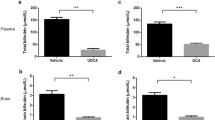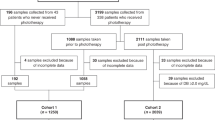Abstract
Treatment with phototherapy or with the lipase inhibitor orlistat decreases plasma unconjugated bilirubin (UCB) concentrations in hyperbilirubinemic Gunn rats. We investigated the mechanism(s) underlying the effects of orlistat, phototherapy, and combined treatment, using steady-state 3H-UCB kinetics. After three weeks of treatment with orlistat (200 mg/kg chow), phototherapy (19 μW/cm2/nm) or combined treatment, tracer 3H-UCB was administered IV to treated and untreated (control) Gunn rats. Plasma samples and feces were collected every 12h for 60h, and bile for 30 min at 60h. The following results were obtained: 1) each treatment decreased plasma bilirubin levels compared with controls: orlistat– 19%, phototherapy–32%, combined treatment–53%; 2) plasma bilirubin concentrations were strongly, negatively correlated with fractional bilirubin turnover; 3) orlistat treatment induced net transmucosal excretion of UCB into the intestinal lumen, whereas phototherapy increased biliary UCB excretion rate; 4) all treatments profoundly increased the enterohepatic circulation of UCB derivatives, indicating enhanced metabolism by intestinal bacteria. In conclusion, orlistat and phototherapy lower plasma bilirubin concentrations in Gunn rats by increasing (net) intestinal influx of UCB, either by transmucosal excretion (orlistat), or increased biliary secretion (phototherapy). The mechanism of phototherapy and orlistat treatment involves increasing the availability of UCB in the intestinal lumen for fecal excretion and for metabolism by intestinal bacteria.
Similar content being viewed by others
Log in or create a free account to read this content
Gain free access to this article, as well as selected content from this journal and more on nature.com
or
Abbreviations
- BW:
-
body weight
- PT:
-
phototherapy
- UCB:
-
unconjugated bilirubin
References
Shapiro SM 2005 Definition of the clinical spectrum of kernicterus and bilirubin-induced neurologic dysfunction (BIND). J Perinatol 25: 54–59
Ostrow JD 1971 Photocatabolism of labeled bilirubin in the congenitally jaundiced (Gunn) rat. J Clin Invest 50: 707–718
Tan KL 1991 Phototherapy for neonatal jaundice. Clin Perinatol 18: 423–439
Crigler JF, Najjar VA 1952 Congenital familial nonhemolytic jaundice with kernicterus. Pediatrics 10: 169–180
Van Der Veere CN, Jansen PL, Sinaasappel M, Van Der Meer R, Van der Sijis H, Rammeloo JA, Goyens P, Van Nieuwkerk CM, Oude Elferink RP 1997 Oral calcium phosphate: a new therapy for Crigler-Najjar disease?. Gastroenterology 112: 455–462
Yohannan MD, Terry HJ, Littlewood JM 1983 Long term phototherapy in Crigler-Najjar syndrome. Arch Dis Child 58: 460–462
Rosenstein BS, Ducore JM 1984 Enhancement by bilirubin of DNA damage induced in human cells exposed to phototherapy light. Pediatr Res 18: 3–6
Sideris EG, Papageorgiou GC, Charalampous SC, Vitsa EM 1981 A spectrum response study on single strand DNA breaks, sister chromatid exchanges, and lethality induced by phototherapy lights. Pediatr Res 15: 1019–1023
Kotal P, Van Der Veere CN, Sinaasappel M, Elferink RO, Vitek L, Brodanova M, Jansen PL, Fevery J 1997 Intestinal excretion of unconjugated bilirubin in man and rats with inherited unconjugated hyperbilirubinemia. Pediatr Res 42: 195–200
Schmid R, Hammaker L 1963 Metabolism and disposition of C14-bilirubin in congenital nonhemolytic jaundice. J Clin Invest 42: 1720–1734
Lester R, Schmid R 1963 Intestinal absorption of bile pigments. I. The enterohepatic circulation of bilirubin in the rat. J Clin Invest 42: 736–746
Van Der Veere CN, Schoemaker B, Bakker C, Van Der Meer R, Jansen PL, Elferink RP 1996 Influence of dietary calcium phosphate on the disposition of bilirubin in rats with unconjugated hyperbilirubinemia. Hepatology 24: 620–626
Chowdhury JR, Kondapalli R, Chowdhury NR 1993 Gunn rat: a model for inherited deficiency of bilirubin glucuronidation. Adv Vet Sci Comp Med 37: 149–173
Zenone EA, Stoll MS, Ostrow JD 1982 The effect of elimination of environmental light on the metabolism of unconjugated bilirubin in the Gunn rat. Dig Dis Sci 27: 1117–1120
Nishioka T, Hafkamp AM, Havinga R, vn Lierop PP, Velvis H, Verkade HJ 2003 Orlistat treatment increases fecal bilirubin excretion and decreases plasma bilirubin concentrations in hyperbilirubinemic Gunn rats. J Pediatr 143: 327–334
Hafkamp AM, Havinga R, Sinaasappel M, Verkade HJ 2005 Effective oral treatment of unconjugated hyperbilirubinemia in Gunn rats. Hepatology 41: 526–534
Bayon JE, Pascolo L, Gonzalo-Orden JM, Altonaga JR, Gonzalez-Gallego J, Webster C, Haigh WG, Stelzner M, Pekow C, Tiribelli C, Ostrow JD 2001 Pitfalls in preparation of (3)H-unconjugated bilirubin by biosynthetic labeling from precursor (3)H-5-aminolevulinic acid in the dog. J Lab Clin Med 138: 313–321
Webster C, Tiribelli C, Ostrow JD 2001 An improved method for isolation of unconjugated bilirubin from rat and dog bile. J Lab Clin Med 137: 370–373
Zilversmit DB 1960 The design and analysis of isotope experiments. Am J Med 29: 832–848
Lepage G, Roy CC 1986 Direct transesterification of all classes of lipids in a one-step reaction. J Lipid Res 27: 114–120
Cohen AN, Kapitulnik J, Ostrow JD, Webster CC 1986 Effect of combined treatment with 2,3,7,8-tetrachlorodibenzo-p-dioxin and phototherapy on bilirubin metabolism in the jaundiced Gunn rat. Hepatology 6: 490–494
Tiribelli C, Ostrow JD 2005 Intestinal flora and bilirubin. J Hepatol 42: 170–172
Kapitulnik J, Gonzalez FJ 1993 Marked endogenous activation of the CYP1A1 and CYP1A2 genes in the congenitally jaundiced Gunn rat. Mol Pharmacol 43: 722–725
Kotal P, Fevery J 1990 Urobilinogen-i is a major derivative of bilirubin in bile of homozygous Gunn rats. Biochem J 268: 181–185
Stoll MS, Zenone EA, Ostrow JD 1981 Excretion of administered and endogenous photobilirubins in the bile of the jaundice gunn rat. J Clin Invest 68: 134–141
Howe RB, Berk PD, Bloomer JR, Berlin NI 1970 Preparation and properties of a specifically labeled radiochemically stable 3H-bilirubin. J Lab Clin Med 75: 499–502
Lester R, Klein PD 1966 Biosynthesis of tritiated bilirubin and studies of its excretion in the rat. J Lab Clin Med 67: 1000–1012
Guerciolini R 1997 Mode of action of orlistat. Int J Obes Relat Metab Disord 21: S12–S23
Vitek L, Zelenka J, Zadinova M, Malina J 2005 The impact of intestinal microflora on serum bilirubin levels. J Hepatol 42: 238–243
Rubaltelli FF, Carli M 1971 The effect of light on cutaneous bilirubin. Biol Neonate 18: 457–462
Acknowledgements
The authors would like to thank Prof.Dr. Ronald P.J. Oude Elferink for valuable discussions and Herman Velvis for technical support regarding HPLC.
Author information
Authors and Affiliations
Corresponding author
Additional information
Grant support by the ‘Najjar Fonds,' by the Fondo Studi Fegato-ONLUS (FCRT 01/00) and the Italian Ministry of Education and Research is gratefully acknowledged.
Rights and permissions
About this article
Cite this article
Hafkamp, A., Havinga, R., Ostrow, J. et al. Novel Kinetic Insights into Treatment of Unconjugated Hyperbilirubinemia: Phototherapy and Orlistat Treatment in Gunn Rats. Pediatr Res 59, 506–512 (2006). https://doi.org/10.1203/01.pdr.0000203180.79636.98
Received:
Accepted:
Issue date:
DOI: https://doi.org/10.1203/01.pdr.0000203180.79636.98



